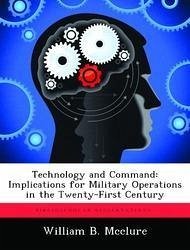The introduction of advanced technologies into the military, which is known as the "revolution in military affairs," is producing an opportunity for significant changes in the American military`s paradigm for command and control. The future battlespace will require commanders to operate more efficiently and at a higher operations tempo, so that commanders will be able to use the advantages of dominant battlespace awareness to enhance what is known as "command-by-intent." But the more likely outcome is a return to command-by-direction. A potential consequence of this change is that significant command functions will be made by machines that act, not as an assistant, but as the decision maker and executor - which is known as the machine commander. However, the current U.S. military doctrine is inconsistent about the admissibility of such an entity, even though technological developments are on the threshold of delivering the components for constructing the first-generation machine commander. Furthermore, the same infrastructure that assists the traditional human commander creates a framework for using a machine commander. While resistance to this technology is expected, this is the proper time to examine the implications of a machine commander for military operations in the future.








